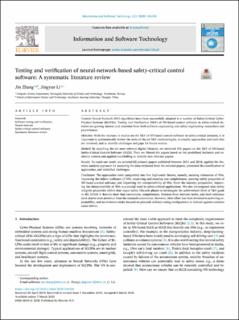Testing and verification of neural-network-based safety-critical control software: A systematic literature review
Peer reviewed, Journal article
Published version

Åpne
Permanent lenke
https://hdl.handle.net/11250/2723938Utgivelsesdato
2020Metadata
Vis full innførselSamlinger
Sammendrag
Context: Neural Network (NN) algorithms have been successfully adopted in a number of Safety-Critical Cyber-Physical Systems (SCCPSs). Testing and Verification (T&V) of NN-based control software in safety-critical domains are gaining interest and attention from both software engineering and safety engineering researchers and practitioners.
Objective: With the increase in studies on the T&V of NN-based control software in safety-critical domains, it is important to systematically review the state-of-the-art T&V methodologies, to classify approaches and tools that are invented, and to identify challenges and gaps for future studies.
Method: By searching the six most relevant digital libraries, we retrieved 950 papers on the T&V of NN-based Safety-Critical Control Software (SCCS). Then we filtered the papers based on the predefined inclusion and exclusion criteria and applied snowballing to identify new relevant papers.
Results: To reach our result, we selected 83 primary papers published between 2011 and 2018, applied the thematic analysis approach for analyzing the data extracted from the selected papers, presented the classification of approaches, and identified challenges.
Conclusion: The approaches were categorized into five high-order themes, namely, assuring robustness of NNs, improving the failure resilience of NNs, measuring and ensuring test completeness, assuring safety properties of NN-based control software, and improving the interpretability of NNs. From the industry perspective, improving the interpretability of NNs is a crucial need in safety-critical applications. We also investigated nine safety integrity properties within four major safety lifecycle phases to investigate the achievement level of T&V goals in IEC 61508-3. Results show that correctness, completeness, freedom from intrinsic faults, and fault tolerance have drawn most attention from the research community. However, little effort has been invested in achieving repeatability, and no reviewed study focused on precisely defined testing configuration or defense against common cause failure.
